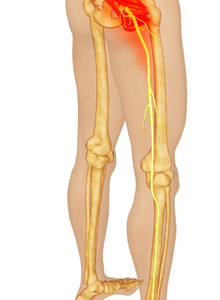Piriformis (Pain in Buttocks)


Buttock Pain – Causes and Treatment:
Piriformis Syndrome (Buttocks ache) is a depressing condition wherein the Piriformis Muscle gets overly tight resulting in either compressing the Sciatic Nerve or pulling its point attaching to bone (Piriformis Tendinosis) or both.
Piriformis Causes:
- Although there are often underlying biomechanical/physical problems that make contributions to this Syndrome (such as bow legs or knock knees, high or low arches, leg length discrepancy, pelvic deficiency, any past injury or trauma, obesity, sedentary lifestyle / over-training, poor posture, too much time on concrete, years of cruddy footwear, etc, etc,), pathological tightness of the FASCIAL ADHESIONS and/or TENDINOSIS mainly leads to piriformis syndrome.
- Piriformis Syndrome can be aggravated by bending, lifting, sports, working out, running, and even by driving (foot on the gas pedal), However sitting tends to be the worst aggravating factor for most people.
- A serious inability to sit down without extreme buttock ache and/or Sciatica is a large crimson flag as far as Piriformis Syndrome is concerned.
Foot Problems & Piriformis Syndrome
If you have extra-high arches or extremely flat feet, or if you have abnormal lower body biomechanics of any sort; you probably need arch supports (orthotics). People with flat feet tend to be “knock-kneed” because the more the arch collapses, the more it drives your knees towards each other.
What are the Signs and Symptoms?
- Piriformis syndrome is the name given to pain if the muscle turns ‘tight’ or irritated. The piriformis muscle can put stress on the sciatic nerve, which reasons to aches – and this can goes down the leg (sciatica).
- The majority of the pain is felt inside the buttock. The pain from piriformis syndrome develops through the years with most players not noticing a particular twist or incident while playing. A stiff and tight lower back can also be related to piriformis syndrome.
- There are many causes of piriformis syndrome. Having tight adductor muscles (the groin muscles inside your thigh) means the outside muscles of your thigh cannot work possible and put more strain on the piriformis.
Physiotherapy Management:
The non-invasive treatments include physical therapy, (osteopathic) manipulative treatment, and lifestyle modification.
Short-term Goals:
- Decreasing Inflammation
- Decreasing Pain
- Decreasing spasm
Goals can be modified for each patient after subsiding their initial symptoms.
Long-term Goal:
- Improve and Maintain Flexibility.
- Improve strengthening
According to Conley et al., the most commonly reported physical therapy interventions include ultrasound, soft tissue mobilization, piriformis stretching, hot packs or cold spray, and various lumbar spine treatments The intervention focused on functional exercises. Therapy Exercises for the Hip aimed at strengthening the hip extensors, abductors, and external rotators, as well as correcting faulty movement patterns
To accomplish a 60% – 70% improvement, the patient pursues 2 – 3 sessions per week for 2-3 months, proceeding with myofascial release to lumbosacral paraspinal muscles followed by McKenzie exercises. At the point, when the patient lies in the FAIR position, the lumbosacral corset can be used.
Home Program
- Rolling side to side with flexion and extension of the knees while lying on each side
- side to side rotation in a standing position with relaxed arms for 1 minute every few hours
- Take a warm bath
- Lie flat on the back and raise the hips with your hands and pedal with the legs like you are riding a bicycle
- Knee bending up to 6 repetitions every few hours.
Do’s and Don’ts
- Avoid sitting for a long period
- Stand and walk every 20 minutes
- Make frequent stops While driving to stand and stretch
- Prevent trauma to the gluteal region
- Avoid further offending activities.
- To avoid the recurrence of the piriformis syndrome, Daily stretching is recommended
Are you looking for physiotherapy treatment for Sciatica?
Contact progressive care physiotherapy and rehabilitation center for more details
Check out these links for relevant information: Pain management
